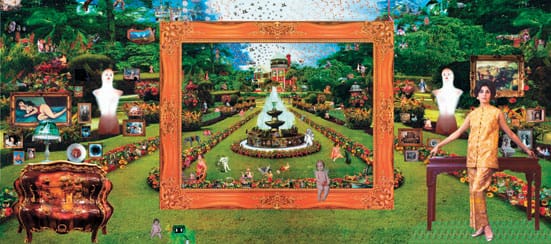22nd September 2006 — 9th December 2006
Global
Photography Now provides a survey of some of the most exciting
contemporary photographic practices from around the globe.
Presentations by leading international curators and artists
are followed by lively panel discussions and audience questions.
Issues of national identity are discussed alongside the pushing
of the boundaries of the photographic medium. So far the series
has included The Middle East, Post-Soviet States, The Indian
Subcontinent, The Balkans and Latin America. If you missed
them you can watch the webcasts on the Tate's website.
East Asia Saturday 18 November 2 - 5
pm At this discussion
artists Qiu Zhijie (Shanghai), Yeondoo Jung (Seoul), Yao
Jui-Chong (Taipei) and Japanese curator Masafumi Fukagawa
(Kawasaki Museum of Art) share their personal perspectives.
Cut through the hype surrounding East Asian art and find
out what's going on for yourself. East Asia has gone
through dramatic changes over the last twenty years, prompted
by phenomenal economic growth. Japan's art scene continue
growing even as its powerful economy slipped into recession
in the 1990s, and South Korea's art and cinema, while badly
affected by the economic crisis of 1997, has gone from strength
to strength. Chinese art entered the international mainstream
as economic reforms, begun in the 1980s, have turned the
People's Republic into an emergent superpower. The ongoing
dispute over the political status of Taiwan only seems to
have increased the island's desire to become a force at international
art festivals, they presented an impressive pavilion at the
Venice Biennale 2005. East Asian artists have become a regular
fixture on the international art scene and an increased number
of major festivals have been set up in the region, with six
major biennials taking place this autumn. These artists have
used their new status to question established traditions
and Western artistic models as much as social, economic and
political conditions.
North Africa Friday 1 December 2 - 5pm Artists Lara
Baladi, who is Lebanese, living in Cairo Yto Barrada, who
lives in Tangier and Paris, Omar D who lives between Paris
and Algiers and Susan Hefuna who is Egyptian/ German discuss
their work with Iranian-Lebanese independent curator Rose
Issa. Issa is one of the major curators for art from the
Near East, Iran, and North Africa, a field she has been active
in for 20 years.
An increased but superficial interest in the Muslim world
is currently evident in the West, exemplified by the fracas
surrounding Jack Straw and his comments on veiling. There
is a growing dissatisfaction with this misrepresentation
of the Arab world and artists from Muslim backgrounds are
seeking to make their own voices heard. Photographic images
of North Africa, over the last century, have mapped out the
modernisation of the social, political, economic and colonial/post-colonial
situations of the region. With the current shifts in the
region dictated by the rise in militarisation, religious
extremism and urban sprawl, contemporary photographers are
choosing to document the realities of daily life within this
fast-transforming region, including immigration to Europe.
The Cinematheque de Tangier, a resource of video and film
work from across the Arab world, founded by Yto Barrada is
currently installed at the Photographers' Gallery.
You may have seen Yto Barrada's work, 'A Life
Full of Holes: The Strait Project’ at the Photographers'
Gallery earlier this year when she was nominated for the
Deutsche Borse Photography Prize 2006. A sense of melancholy
and dislocation pervades Barrada’s work. Until 1991
Moroccans could travel to Europe freely but since the EU
sealed their borders the Strait of Gibraltar has become a
one-way passage. Europe is now an illusory paradise with
a psychologically damaging hold on Moroccans who dream of
escaping there. In Barrada's
photographs, wallpaper of an Alpine scene fades in Tangier.
Two children are silhouetted against a light box advertisement
for a ferry, yearning towards the impossible journey to Europe.
A close-up of rust holes in a container ship evokes the desperation
of stowaways. A girl in a red flowery dress faces a brightly
patterned Islamic tiled wall, refusing communication. In
the street, a boy carries a model ship past a group of women
in headscarves.
Next in series: Asia Pacific on Friday 8 December and West
Africa on Saturday 9 December, see Tate website for details.
AMG
Tate Modern
Bankside
London SE1 9TG
http://www.tate.org.uk/modern
Open
Daily, 10am-5.50pm

"Perfumes & Bazaar, The Garden of Allah". Photographic montage, pigment print on self adhesive vinyl and duratrans print for lightbox, dimesions variable. Copyright Lara Baladi, 2006